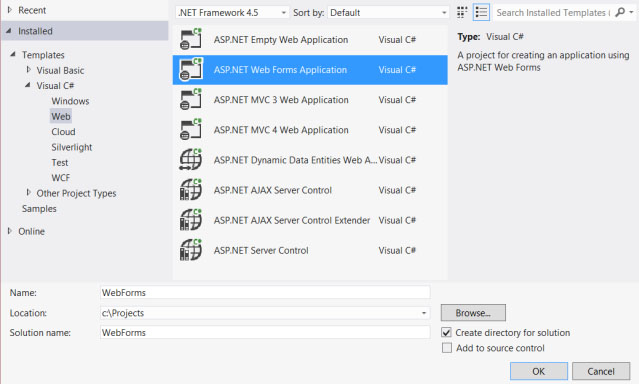Forms
A web form is one of the programming models available in ASP.NET.
The forms are merely pages produced using a combination of HTML, scripting, server controls, and server code. Its general behavior occurs as follows: the user requests a page, the framework compiles and executes the page on the server, and the framework produces HTML markup for the browser.
Visual Studio allows for quick and easy development through drag and drop addition of server controls to the layout. The remaining development consists of setting properties, methods, and events for controls (or events for the page). Properties, methods, and events define the behavior of the page along with its appearance. Any of the various languages supported by .NET can be used to produce server code.
Web forms allow the separation of HTML and other user interface code from the logic of the application making code clean and maintainable. ASP.NET offers a wide selection of server controls for the most common tasks. The forms offer robust data binding and excellent tool support. They also support client-side scripting, which executes in the browser; furthermore, many other capabilities are supported such as routing, error handling, and state management.

These forms combat some of the challenges in web development:
- Interface Development – Designing and implementing an interface with a complex design and substantial dynamic content proves tedious and challenging. ASP.NET simplifies this process through an object model, an intuitive process focusing on elements and events, and server controls that bring browser-server interaction into focus. These tools strip thinking about HTML away from the process.
- Client and Server Separation – Web applications suffer under the strain of the client and server running different applications on different machines and only sharing small bits of simple information. ASP.NET essentially automates the entire process of this interaction through an abstracted model, which remains invisible to the developer.
- Stateless Execution – Servers have no memory of the requests they satisfy, and this lack of state information presents a constant battle in the age of web applications with rich functionality. ASP.NET automatically manages state and offers clear, specific, and simple options for management.
- Client Diversity – One of the most difficult things for a developer is supporting the various clients, devices, and configurations which will access their application. ASP.NET eliminates the need to target browsers by focusing on the server, however, it still allows developers to optimize their application for a browser.
- Scalability – This quality, in the age of the cloud, ranks as high as any other basic functional aspect of software. ASP.NET allows for scalability without heavy code modification.
When deciding between using Web Forms and another model, web forms become a clear choice for small teams who want to exploit the huge selection of components available for rapid development. Forms also accelerate development due to requiring far less code than MVC.